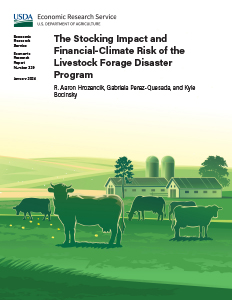The Stocking Impact and Financial-Climate Risk of the Livestock Forage Disaster Program
- by R. Aaron Hrozencik, Gabriela Perez-Quesada and Kyle Bocinsky
- 1/30/2024
Overview
Drought imposes significant costs on the U.S. agricultural sector, particularly livestock producers who rely on precipitation to grow forage. The U.S. Department of Agriculture administers several programs to mitigate the economic costs of drought. One of these programs is the Livestock Forage Disaster Program (LFP), which provides payments to livestock producers impacted by drought. Program evaluation results suggest that producers in drought affected counties that received LFP payments achieved similar herd retention and liquidation outcomes as producers in less drought impacted counties that were ineligible for LFP payments. Modeling results suggest that LFP poses a financial-climate risk to the Federal budget. Depending on the future emissions scenario, annual Federal Government expenditures on LFP are projected to increase above the current average expenditures by 45–135 percent (in 2022 dollars) by 2100.
Hrozencik, R. A., Perez-Quesada, G., & Bocinsky, K. (2024). The stocking impact and financial-climate risk of the Livestock Forage Disaster Program (Report No. ERR-329). U.S. Department of Agriculture, Economic Research Service. https://doi.org/10.32747/2024.8254668.ers
Download
-
Entire report
Download PDF -
Report summary
Download PDF

